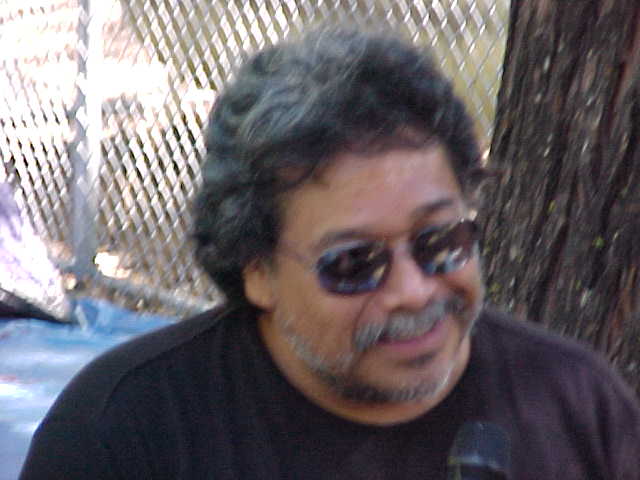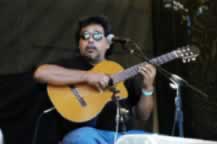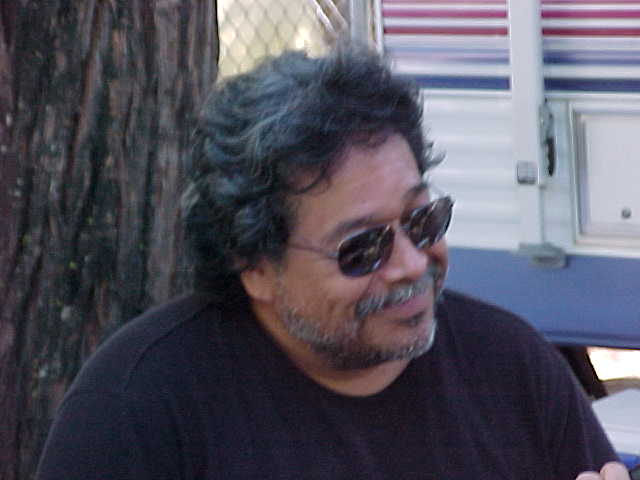Cantautor
de Oaxaca, Mexico



Photo by: Rick Breeze-Martin
Photo by: Diane Shannon
Photo by: Rick Breeze-Martin
Considered among Southern Mexico?s finest contemporary composers, cantautor Victor Martinez has appeared in music festivals across Mexico and the Caribbean, on the stage at the Palace of Fine Arts in Mexico City, and in theatres, plazas and university campuses throughout Mexico, California and Texas.

The generic name ?son? is a popular manifestation that has evolved from ancestral roots, a syncretism of the Indigenous, the African and the Spanish. Building on this traditional music of his native Oaxaca, Victor?s music reflects as well the influence of John Lennon, Scott Joplin, even the Gypsy Kings. A student of genres ranging from rock to blues to the Cuban son, Victor?s music has both diverse sound and appeal.
?Victor Martinez, instead of vocal chords, has his voice muscles intertwined with the deepest roots of his Oaxaca. ?and so the color of his voice, the flavor of the fruit, the allegories, the lullabies, flow from the heart of this public man. His voice meets the ear like a shining earring, harmonious, a blessing.?
Julio Ramirez, The Cultural Institute of Oaxaca
?My creative project is to make popular music in Oaxaca, starting with our sones, our matrix of regional differences, but always open to other influences, whether Anglo-Saxon, European, African or Asian. The important thing is the convivencia in diversity.?
?Inspiration is an idea of the world, but without dependence, not on religion, nature, history, race, ethnicity, nor ideology. Poetry exists, there it is. It is life itself. I sing to children, to lost love, to the iguana, the hammock, the agave, the limestone? to rain, the pineapple flower, the sun, the moon, death and life.?
(photos at top of page taken at Strawberry Music Festival, Camp Mather, California, September 2004, end photos taken during an interview with Gregg McVicar of Earth Song, and the center photo while performing on the main stage Sunday afternoon.)
"El respeto al
derecho ajeno es la paz."
Lic. Benito Juarez de Oaxaca,
Mexico
("Respect for
the rights of others is peace.")
Click here for information on the
Victor Martinez 2008 Northern California Concert Series
FANDANGO (Party)
Fandango is the generic name for Mexican music used for 500 years to identify mestiza music that comes from flamenco. This song is a slow version of the fandango and talks of the sacredness of love and femininity.
SON DE CUNA (Cradle Song)
This is a more intense rhythm that invites us to dance. It is a song that speaks to our fidelity to children. We want our children to dream ? about rivers, clouds, and about our own dreams. In the middle of the song, I mention a dance, an invitation to make a child.
LA HAMACA (The hammock)
Another slow piece, this time about a hammock. This song is called a petenera. It speaks to a piece of furniture that serves for everything ? but especially for rocking, a movement that suggests daydreaming, especially about loved ones who have departed or those we feel very close to.
PARA QUE FLOREZCA (Let them Bloom)
Children need to hear what adults think about them. These lyrics mention the responsibility and transcendence of existence of one or millions of children. It also mentions our worries about them. In the chorus, the image of love of a mother breast-feeding her child.
PETENERA DE LA SIRENA (The Mermaid)
Fishes that fly, the sea that calls to us, the imaginary song and the depth of our feelings appear in this story about men and women who turn into fish. Mermaids and tritons are images of impossible love, or of our insecurities about falling in love.
SOLILUNA (Sunandmoon)
In Spanish, every thing has a gender, masculine or feminine. This song is a game where little boys turn into trees, thunder or lightening ? and little girls, into water, fruit, clouds or rain.
VALS EN BLANCO Y NEGRO (Waltz in Black and White)
The moon appeared at my window and I let her in. She undressed and walked around my house ? she followed me with her reflections. She was like a tattoo of the night. She filled my house, and my life filled with her.
EL SON DEL TRINO (Song of Songs)
Trill ? everything that exists trills or makes its own music, especially when we feel, when our emotions soar - when we have the motivation to live with more intensity.
DANZA Y LAMENTO (Dance and Lament)
?Little doe, dear one, they have killed you and I loved you so.? Death is part of the cycle of life. We live only from here until our death. And then, what fortune, death itself dies in this dance and lament.
RACION DE TIEMPO (Ration of Time)
The universal theme of the limitations of time and space in interpersonal relationships.
LA BRUJA (The Witch)
Mythical character in popular Mexican poetry who plays with our innocence and passions. She leads us on, seduces us and plays with us. That?s why we call her the witch!
RECUERDOS DE MARIA (Recollections of Maria)
Poetic description of a lost love.
AGUALUNA (Watermoon)
Intense rhythm accompanies our emotions in this dance to the water-moon, who swishes her tail as she swims away.
ESPEJO DE NUBE (Cloud Mirror)
A city can exist in its own reflection on the clouds in the sky. It is a replica in a mirror that people experience if they converse with time and archtypes. They can discover history just looking up at the sky.
QUEDATE (Stay, Please Stay)
Stay, please stay here with me tonight. Cover what escapes from my dreams.
SOMOS YA OTROS (We are another now)
Love daydreams of magnetized beings - two individuals come together as one or as a half, dying and reviving in a single embrace. We are the wind, the sea, the living dream.
ARQUIDIOCESIS (Blues of the Archdiosis)
My city, Oaxaca, has more than 40 churches. Here I?m making a little fun of our religious tradition as I plan to meet a lady in different churches with names like the Church of Solitude, of Consolation, of Poverty and of the Seven Princes.
SON DEL AGUA (Water Song)
Water pleases us and represents for us sensations and feelings, even though it is now bought and sold, both wholesale and retail ? a concept foreign to our indigenous tradition.
 Click here to purchase Victor's CD's
Click here to purchase Victor's CD's